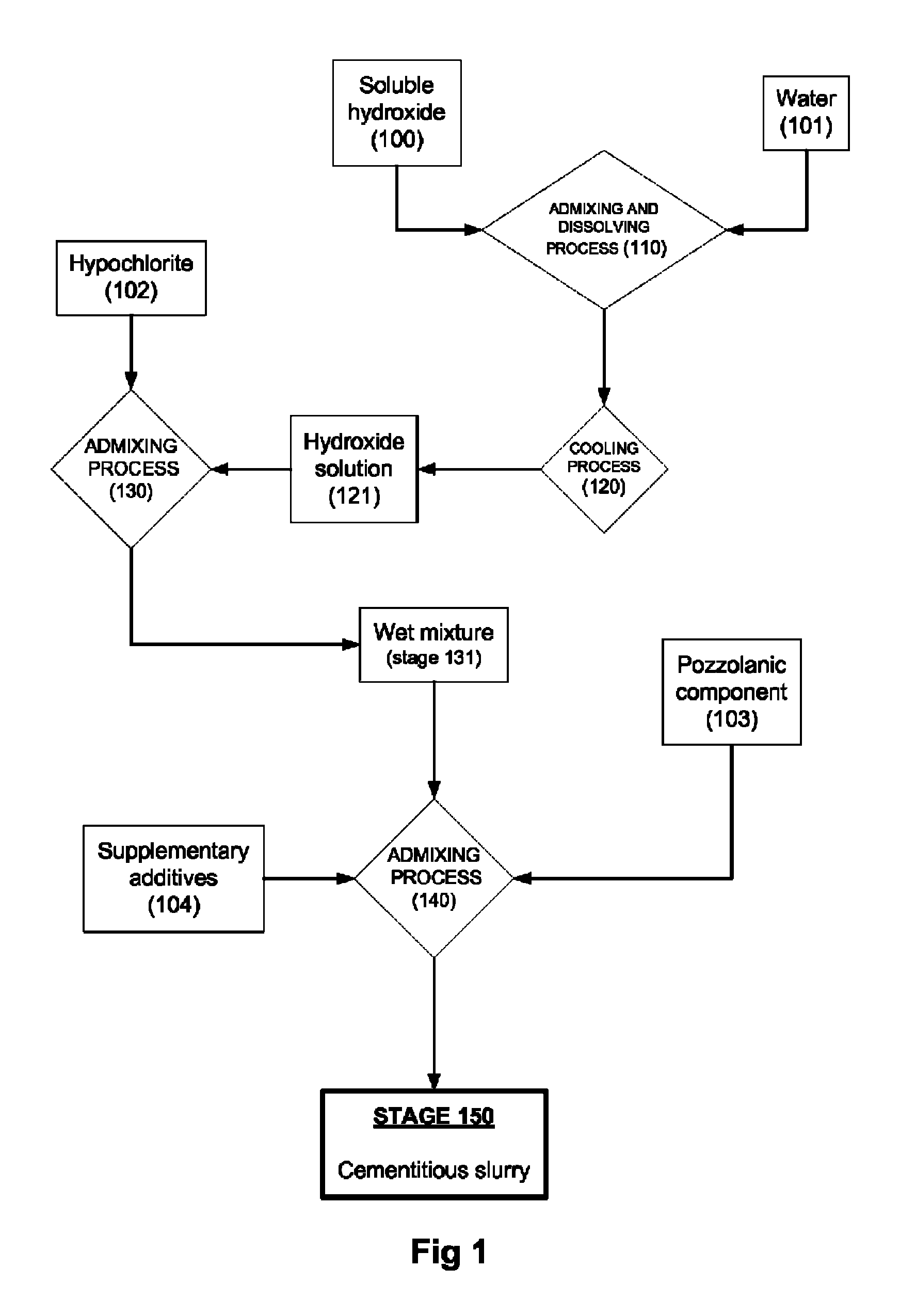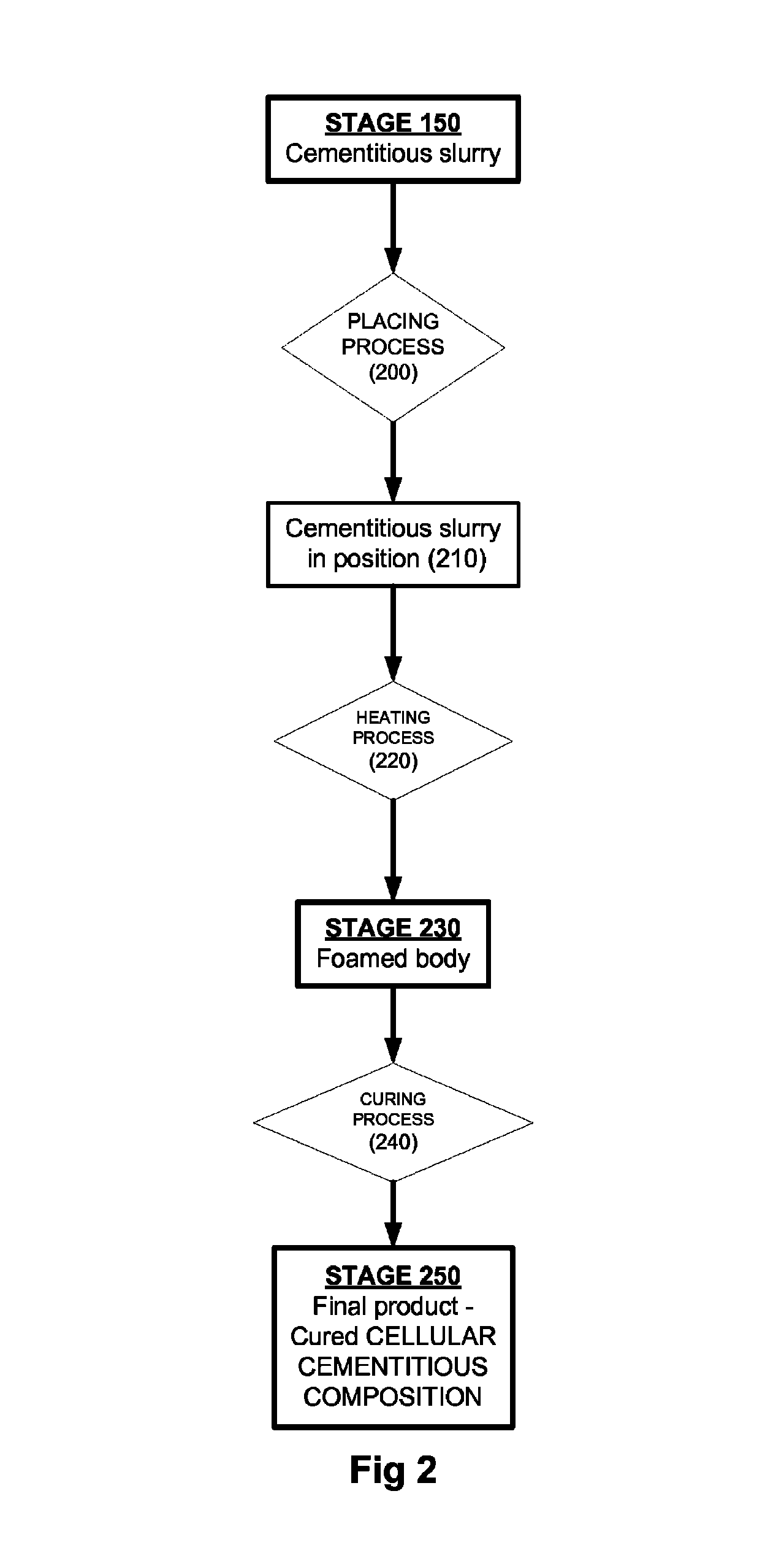Cellular cementitious composition
- Summary
- Abstract
- Description
- Claims
- Application Information
AI Technical Summary
Benefits of technology
Problems solved by technology
Method used
Image
Examples
example 1
Components
[0185]Lethabo fly ash=360 g
[0186]47% sodium hydroxide solution=120 ml
[0187]Water=40 ml
[0188]HTH chlorine granules=60 g
Method:
[0189]Add and mix water to the 47% sodium hydroxide solution to form a hydroxide solution. Mix and grind HTH granules into the hydroxide solution using a pestle and mortar to form a wet mixture at approximately ambient room temperature. Add and mix all the fly ash, a pozzolanic component composed of substantial amounts of reactive aluminosilicate, to the room temperature wet mixture in a 2 litre polythene container to form a cementitious slurry. Leave the slurry for half an hour to settle into a pasty consistency. Place the container with the slurry into a kitchen pressure cooker and autoclave for 3 hours, topping up the pressure cooker with water at hourly intervals. A cured, hardened and lightweight product of cellular cementitious composition is the result that may be dropped out of the container.
example 2
Components
[0190]Lethabo fly ash=300 g[0191]47% sodium hydroxide solution=100 ml[0192]Water=10 ml[0193]HTH chlorine granules=30 g
Method:
[0194]Add and mix the water component to the sodium hydroxide solution component to form a hydroxide solution. Mix and grind the HTH granules component into the hydroxide solution using a pestle and mortar to form a room temperature wet mixture. Add and mix the fly ash, a pozzolanic component, to the room temperature wet mixture in a 2 litre polythene container to form a cementitious slurry. Leave the slurry for fifteen minutes to settle into a pasty consistency. Place the container with the slurry into an oven at 50° C. for 45 minutes to allow for foaming and setting of the slurry into a foamed body. Place the foamed body into a kitchen pressure cooker and autoclave for 4 hours, topping up the pressure cooker with water at hourly intervals. A cured, hardened and lightweight product of cellular cementitious composition is the result that may be dropp...
example 3
Components
[0195]Lethabo fly ash=120 g[0196]47% sodium hydroxide solution=45 ml[0197]HTH chlorine granules=45 g
Method:
[0198]Mix and grind the HTH granules component into the 47% sodium hydroxide solution component using a pestle and mortar to form a room temperature wet mixture. Add the fly ash component to the room temperature wet mixture in a 2 litre polythene container and mix for ten minutes to form a cementitious slurry. Place the container with the slurry into an oven at 70° C. (that also holds an open dish of water for the purpose of keeping a high humidity) for 25 minutes. Place the container into a kitchen pressure cooker and autoclave for 3 hours, topping up the pressure cooker with water at hourly intervals. A foamed, cured, hardened and lightweight product of cellular cementitious composition is the result that may be dropped out of the container.
PUM
| Property | Measurement | Unit |
|---|---|---|
| temperature | aaaaa | aaaaa |
| temperature | aaaaa | aaaaa |
| temperatures | aaaaa | aaaaa |
Abstract
Description
Claims
Application Information
 Login to View More
Login to View More - R&D
- Intellectual Property
- Life Sciences
- Materials
- Tech Scout
- Unparalleled Data Quality
- Higher Quality Content
- 60% Fewer Hallucinations
Browse by: Latest US Patents, China's latest patents, Technical Efficacy Thesaurus, Application Domain, Technology Topic, Popular Technical Reports.
© 2025 PatSnap. All rights reserved.Legal|Privacy policy|Modern Slavery Act Transparency Statement|Sitemap|About US| Contact US: help@patsnap.com



